How To Calculate Melting & Boiling Points Using Molality
In Chemistry, you will often have to perform analyses of solutions. A solution consists of at least one solute dissolving in a solvent. Molality represents the amount of solute in the solvent. As the molality changes, it affects the boiling point and freezing point (also known as the melting point) of the solution. You can easily determine what the boiling or freezing point of any solution will be using a simple equation.
Step 1
Note the molality (m) of the solution. A higher molality will increase the boiling point and decrease the freezing point of the solution.
Step 2
Use a table to look up the freezing point depression (Kf) or boiling point elevation (Kb) constant for your solvent (See Resources). Every substance has a unique constant that determines how much one mole of solute will decrease the freezing point or increase the boiling point.
Step 3
Calculate the change in boiling or freezing temperature using one the following formulas: ΔTf = Kf m or ΔTb = Kb m.
Step 4
Add the value obtained for ΔTb to the standard boiling point of the solvent (ex. 100 C for water) or subtract the value obtained for ΔTf from the standard freezing point of the solvent (ex. 0 C for water).
Warning
If the substance ionizes in solution (ex. NaCl), it is necessary to include the Van't Hoff Factor (i). This factor equals the number of ions and is included in the equation as follows: ΔT = Kf * m * i.
Cite This Article
MLA
Raval, Yasho. "How To Calculate Melting & Boiling Points Using Molality" sciencing.com, https://www.sciencing.com/calculate-boiling-points-using-molality-8623435/. 13 March 2018.
APA
Raval, Yasho. (2018, March 13). How To Calculate Melting & Boiling Points Using Molality. sciencing.com. Retrieved from https://www.sciencing.com/calculate-boiling-points-using-molality-8623435/
Chicago
Raval, Yasho. How To Calculate Melting & Boiling Points Using Molality last modified March 24, 2022. https://www.sciencing.com/calculate-boiling-points-using-molality-8623435/
